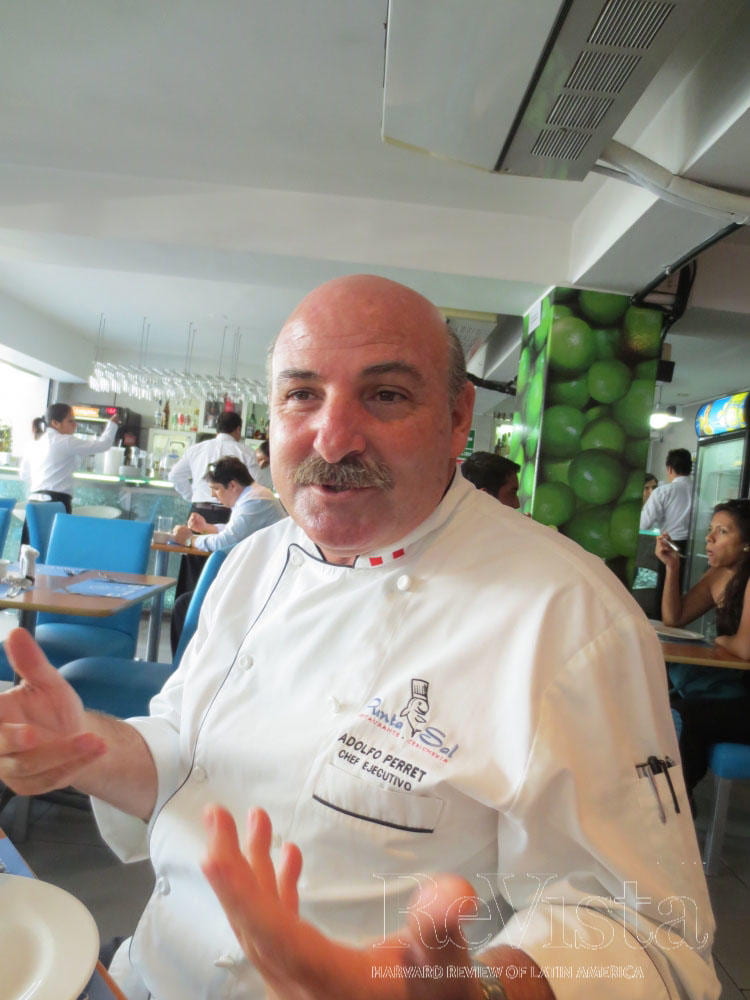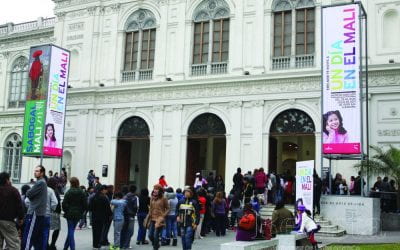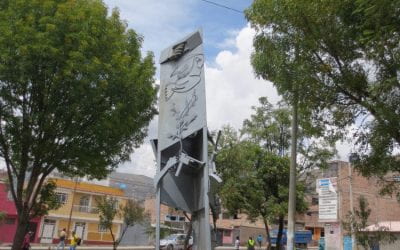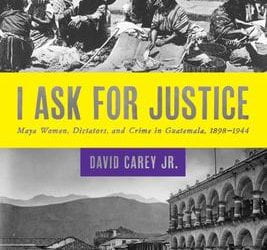Fusion and Identity
A Chef Speaks

Adolfo Perret Bermúdez speaks about Peruvian culinary arts in his Punta Sal restaurant. Photo by June Carolyn Erlick.
I grew up far from Lima in Talara in the Piura region, a northern Peruvian city with stunning beaches that just happens to be the westernmost city in all of mainland Peru. The city enjoys an abundance of fish and shellfish, as well as large oil reserves. The International Petroleum Company (IPCo) settled in Talara in the 1950s, and my father (of Swiss-Peruvian descent) worked for this oil company as a geologist. So I grew up with a deep sense of Peru’s diversity. It is worth mentioning that we are a nation of regions, with desert and sea and mountains and jungle.
Peruvian culture has been influenced by Japanese, Chinese, Arab, Spanish and Italian cultures, and these, integrated with our strong indigenous roots, gave birth to a new Peruvian cuisine.
I grew up learning how to cook, and living in an oasis of seafood. It’s perhaps natural that my six restaurants—with flagship Punta Sal in Lima—are cebicherías specialized in the bounty of the ocean. But what’s just as important to me is the fusion of identities that make up this new Peruvian cuisine.
So, for example, I prepare a ginger rice dish with jumbo shrimp and spareribs—a fusion dish influenced by the Chinese. And our exquisitely Peruvian dish known as tiradito, which is a kind of Japanese sashimi with Peruvian seasoning. The Incas had a multitude of dishes with indigenous ingredients that became transformed during this melding of cultures. In 1528, the Spanish brought olive oil, wheat, olives, grapes and wine, which could also be used to create vinegar to cook and marinate meats. Here, they discovered the use of our abundance of potatoes—some 3,200 varieties—some of which they introduced to Europe.
The Incas called the potato kausaq, a Quechua word which means “sustenance for life,” and this yellow potato became the basis for the well-known Peruvian dish called causa. It combines potato, avocado and a yellow chili pepper known as ají amarillo with the lime, garlic and chicken that originated in Europe.
Most everyone has heard about quinoa by now. It’s one of Peru’s most ancient grains, but it’s also, in my opinion, the grain of the future, because of its great nutritional properties with seven out of the nine amino acids essential for life. Quinoa can be combined in all sorts of ways to produce new flavors. Because of its versatility and resistance to weather changes, it is considered the golden grain of the Incas and of Peru today.
But my goal, whatever the ethnic influence, is staying true to deeply rooted flavors, the best sustainable ingredients and ancestral techniques, and cebiche provides the best example. About 70 percent of Peruvian cuisine is based on seafood ingredients. We hold the 1996 Guinness record for the largest cebiche in the world.
I’m a chef by nature—experimenting with food since I was quite young. I’m also a food and beverage manager with a successful businesswoman and life partner, Gabriela Fiorini, with whom we expanded our chain of Peruvian restaurants specializing in seafood, named Punta Sal.
But perhaps I get the most pleasure from teaching students and communicating to people around the world about the diversity of Peru’s cuisine. I also see myself as a spokesman for that wonder that is Peruvian cuisine—teaching, carrying out Peruvian gastronomic events, traveling to gastronomic fairs and festivals and above all, promoting Peruvian culinary tourism. In Peru, tourism and cuisine go hand in hand to show off our multi-faceted heritage. Gastronomy—like archaeology—is a deep expression of our roots. It is our past, but also our present and future.
Fall 2014, Volume XIV, Number 1
Adolfo Perret Bermúdez is the owner of Punta Sal restaurants in Lima and beyond. Johnson and Wales University has honored him as a Distinguished Visiting Chef.
Related Articles
The Violence of the VIP Boxes
English + Español
In Peru, the upper class does not like to mix with those they consider different or inferior. Their maids on the beaches south of Lima are not allowed to swim in club pools and, sometimes, not even in the ocean. The VIP boxes at sports and theater events maintained by the government are a public display of a private practice that reproduces in the public sphere the worst aspect of private hierarchical structuring.
Peace and Reconciliation
English + Español
Eleven years have gone by since the Peruvian Truth and Reconciliation Commission presented its final report. The report reconstructed the history of many cases of massacres, tortures, murders and other serious crimes. At the same time, it contributed an interpretation of the…
I Ask for Justice: Maya Women, Dictators, and Crime in Guatemala, 1898–1944
On May 10, 2013, General Efraín Ríos Montt sat before a packed courtroom in Guatemala City listening to a three-judge panel convict him of genocide and crimes against humanity. The conviction, which mandated an 80-year prison sentence for the octogenarian, followed five weeks of hearings that included testimony by more than 90 survivors from the Ixil region of the department of El Quiché, experts from a range of academic fields, and military officials.




